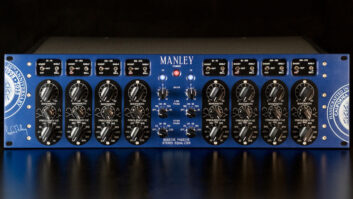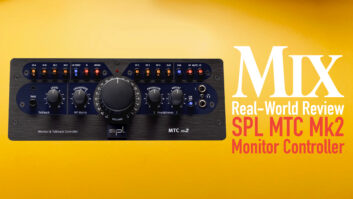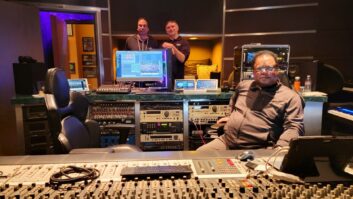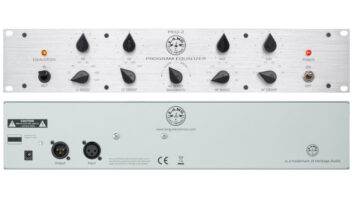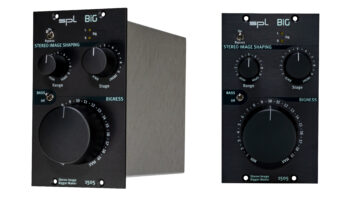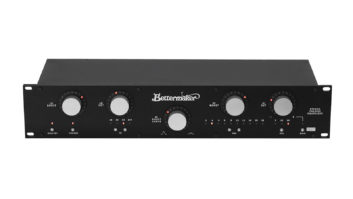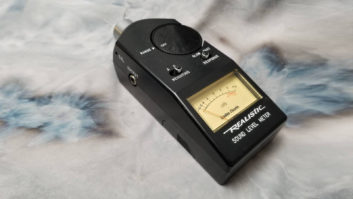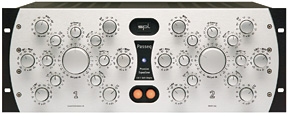
Passive EQs are generally known for their natural and transparent sound. When SPL’s design engineers set out to create the Passeq, one of their goals was to take these inherent qualities to the limit. Each filter in this 2-channel unit was given its own coil, and every coil was placed on its own core — the latter is a first in passive equalizer design — to improve phase performance and minimize THD. Proprietary, discrete 120-volt op amps were also used to provide makeup gain boasting a 116dB signal-to-noise ratio, gargantuan 150dB dynamic range, lightning-fast 200V/ms slew rate and a 100kHz bandwidth.
SPL then added high-performance Lundahl I/O transformers and gave the box a whopping 72 interleaved frequency choices per channel. The result is a very unique and compelling equalizer for tracking, mixing and mastering applications.
IT LOOKS COOL, TOO
The 4U, rackmountable Passeq sports no less than 28 rotary controls on its front panel. Each channel has six switched frequency selectors, which respectively serve three boost and three cut bands equally delegated to cover roughly high, middle and low-frequency ranges (with one boost and one cut band for each range).
Each of the six bands has either a gain boost or gain cut control, and all are detented except those serving the midrange bands. Maximum gain boost is between +10 and +17 dB, and maximum cut is -11.5 to -22 dB, depending on the band chosen. The only Q controls are those serving each channel’s high-frequency boost filter, and these were also not detented on my review unit. However, SPL told me that all controls will be detented by the time you read this. The Passeq’s high-frequency boost and midrange boost and cut filters are all bell configuration. Passeq’s high-frequency cut and low-frequency cut and boost filters are all wideband bell filters that approximate shelving response.
The granddaddy of the Passeq’s controls is the 41-position ALPS output attenuator for each channel. Illuminated channel-bypass switches sit below the power-status indicator on the front panel. The Passeq’s rear panel has balanced XLR I/O connections, power and ground-lift switches, an IEC receptacle for the detachable AC cord and a 110/220V voltage selector.
PLEASE, USE THAT TONE WITH ME
I used the Passeq both on individual tracks and across my mixer’s stereo bus at mixdown. In every application, the Passeq’s filters sounded smooth, focused and pristine. In subtle ways, tracks processed with the Passeq sounded as if they had been recorded using better mic preamps — highs sounded sweeter, mids smoother and lows rounder.
I had to use more EQ than usual to hear the Passeq working. Conversely, I could get away with using a lot more boost or cut than I normally would have applied without a hint of smearing or edginess. With almost 6 dB of boost at 15 kHz on a stereo acoustic guitar track, the high end sounded eminently sweet. Transients were preserved on kick, snare and tom tracks, even with considerable equalization applied. Electric bass sounded phenomenal with its bottom end boosted — warm and round, but with no hint of blurriness. I also got superb results equalizing lead vocals and electric guitar tracks.
Boosting 80 Hz and 13 kHz on a full mix lent a more rounded and detailed sound with added nuance. The unit did not distort, even when delivering +26.5dBu mix bus levels to the inputs. Maximum input and output levels are stated to be +28 dBu and +32 dBu, respectively.
TRANSPARENTLY YOURS
Monochrome knobs made my review unit’s control settings difficult to discern, but SPL maintains this has since been rectified by substituting controls with black indicator lines. However, most of the Passeq’s shortcomings are inherent limitations of its neo-classic passive design. The lack of individual bypasses for each band makes instantaneous before-and-after A/B comparisons impractical. Filter Qs were generally too broad for surgical tracking and mixing apps. And the omission of high- and lowpass filters is a slight hindrance to mastering applications and precludes fashioning a steep bandpass filter (by combining an HPF and LPF) on individual tracks. (The shelving filters have a mild 6dB/octave slope.) However, the Passeq’s raison d’être is its gorgeous sound.
That said, I would have preferred having higher frequencies offered in lieu of the 10, 15 and 18Hz choices included in the low-frequency boost band. Similarly, I can’t remember the last time I effected a high-shelving cut at 580, 780, 1,200 or 1,800 Hz, which are the four lowest frequencies offered for the highest-cut band; I’d prefer a more bountiful choice of even higher frequencies. SPL’s design intent here was that a midrange cut can be made using high shelving at a low corner frequency, countered by a shelving boost at a higher frequency to restore highs.
Such an approach highlights the idiosyncratic nature of working with passive equalizers. But if you’re willing to change your work methods and can afford the $5,200 list price, the Passeq’s stellar sound quality will absolutely delight you. If you’re looking for an ultrapristine 2-channel equalizer with a sweet, smooth, round sound, the Passeq might be your box.
SPL, 951/272-3465, www.spl-usa.com.
Mix contributing editor Michael Cooper is the owner of Michael Cooper Recording in beautiful Sisters, Ore. Visit him at
www.myspace.com/michaelcooperrecording.
